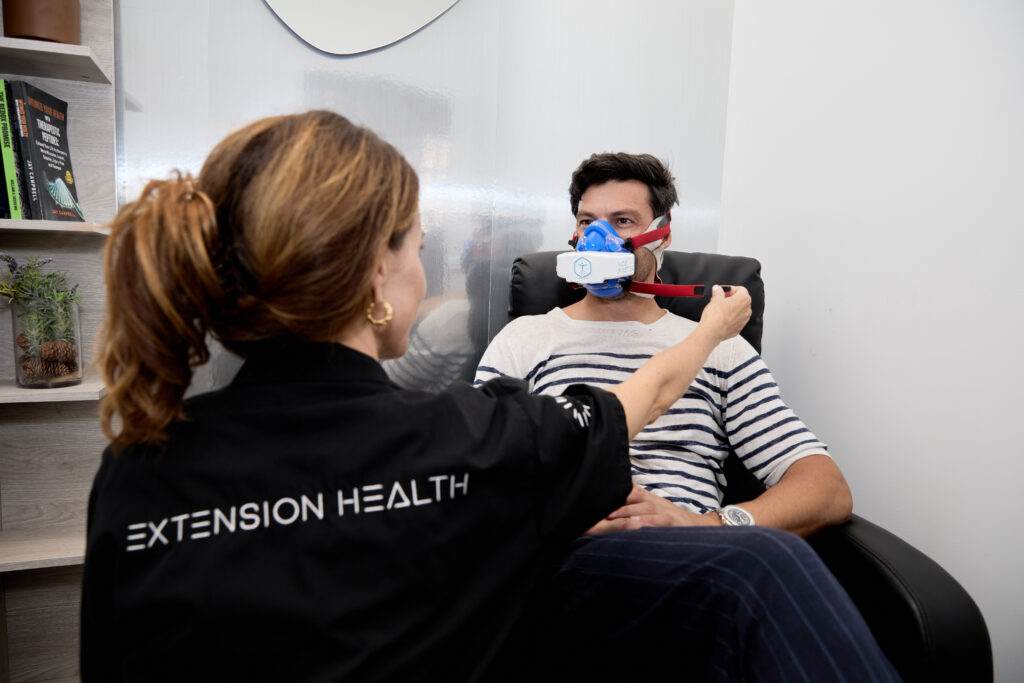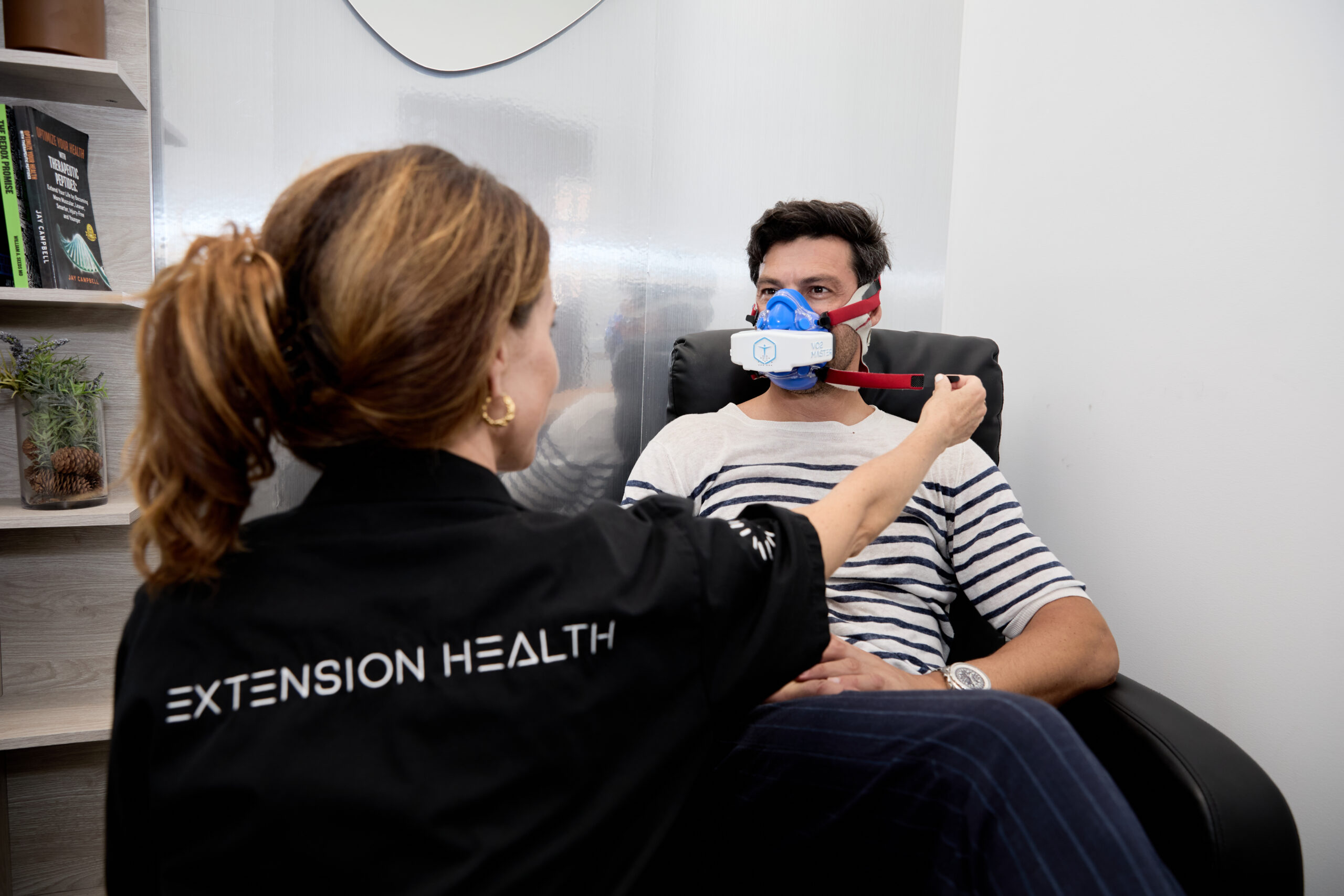resting metabolic rate test Benefits
Achieving your goal weight starts with mastering your metabolism.
A Resting Metabolic Rate (RMR) test decodes the mystery of your metabolism, determining exactly how many calories your body burns at rest. Use this essential rate to build a more personalized diet and exercise plan for more sustainable weight management.
Achieve weight loss that lasts
RMR reveals how many calories you burn at rest, enabling you to create a targeted diet and exercise plan to achieve your weight goals for good.
Take control of your metabolism
Metabolism slows with age, which means your daily calorie burn changes. Regular RMR testing can help you get ahead of metabolic slow-down.
Prevent metabolic disorders
A higher RMR may signal a risk of metabolic disorders. Monitoring it helps you detect early signs and make lifestyle changes to support a healthy metabolism
The RMR Experience
Effective metabolism management comes down to efficiency and precision.
In just 30 minutes, your RMR test eliminates the guesswork around diet and exercise, giving you an accurate look at how your body uses energy.
Prep
You’ll receive detailed preparation guidelines from our team ahead of your RMR test. Generally, we recommend fasting for 6 hours (including caffeine), avoiding intense exercise for 12 hours, and refraining from nicotine and alcohol beforehand.
Test
Your test may last up to 30 minutes, during which you will sit still while wearing a specialized mask that measures oxygen consumption and carbon dioxide production to calculate your energy expenditure.
Review
Right after your test, our clinical team will review your results with you and answer any questions you may have. You’ll leave with your full report in hand—no waiting or follow-up required.
Refine
Use your RMR results to effectively track your progress and make informed changes to your diet and exercise plans.
Patient Testimonials
"It was my lucky day when I came across this clinic, and have had nothing but the best experiences here for the past three years. This is why I have brought three family members for health visits as well. The doctors here are way ahead of the curve in every way. They have my respect and gratitude!"
—Theodora
“Getting the RMR test was a relief. I finally understood how much energy my body actually needs. It explained a lot.”
—Jenn
“I had a wonderful experience at Extension Health. I got my results literally right after I was done and a doctor came to explain it to me. You really feel like you’re in good hands here.”
—Keighley
resting metabolic rate FAQs
Click the drop down for details on each question.
When can I expect my results?
Our team will walk you through your data following your test.
How often should I test my RMR?
We recommend testing your RMR every six months, especially if you are attempting lifestyle changes.
Is a RMR test more accurate than a wearable?
Most wearable calorie trackers estimate burn based on algorithms and data that analyze factors like steps taken. These devices may offer a strong approximation, but they are not always precise. An RMR test directly measures your oxygen consumption and carbon dioxide production to determine your caloric expenditure at rest. Plus, RMR tests are conducted in controlled environments, which also contributes to accuracy.
How should I prepare for my RMR test?
Before your test, fast for 6 hours (including caffeine), avoid intense exercise for 12 hours, and refrain from nicotine and alcohol. Remember to wear comfortable athletic clothing and running sneakers.
Does RMR change with age?
Studies indicate the RMR may decline with age. This decline may be attributed to a few factors. First, decreases in muscle mass may alter the metabolic rates of organs and tissues. Second, the presence of chronic disease may accelerate a change in RMR.
Will my insurance cover the cost of the RMR test?
RMR is self-pay only and not covered by insurance.
How is RMR different from Basal Metabolic Rate (BMR)?
Resting Metabolic Rate (RMR) and Basal Metabolic Rate (BMR) are similar but not identical. Both measure the number of calories your body needs at rest to maintain basic functions like breathing and circulating blood. However, RMR is slightly higher than BMR because it includes the energy expended during normal daily activities, such as sitting or standing. BMR is measured in a strictly controlled, fasting state, while RMR is measured in a more relaxed environment, usually after a few hours of rest.
How does diet affect my RMR?
Diet plays a significant role in your RMR. A high-protein diet can temporarily increase RMR because it requires more energy to digest and metabolize protein compared to fats or carbohydrates. Conversely, severe calorie restriction or very low-calorie diets can lower your RMR, as your body goes into "conservation mode." Consuming balanced meals regularly can help maintain a healthy metabolism.
Can exercise increase my RMR?
Yes, regular exercise, particularly strength training, can increase your RMR over time. Building muscle mass boosts your RMR because muscle tissue requires more energy to maintain than fat tissue. Aerobic exercise can also improve metabolic efficiency, though the effect on RMR may be less significant than strength training. Consistent physical activity helps ensure your metabolism remains elevated.
How long does an RMR test take?
An RMR test typically takes around 20 to 30 minutes. During the test, you’ll relax in a reclined position while breathing into a mask or mouthpiece. The test is non-invasive and requires no special preparation, aside from fasting for a few hours before the test to ensure accurate results.
We also recommend
Your health journey doesn’t stop here — it’s all connected. That’s why we recommend pairing this service with the Comprehensive Diagnostics Package.
Comprehensive Diagnostics Package
Build a strong foundation for your long-term health with a package that covers your cardiovascular, metabolic and musculoskeletal health, as well as your aging biomarkers.
Includes
-
Learn moreLearn more

